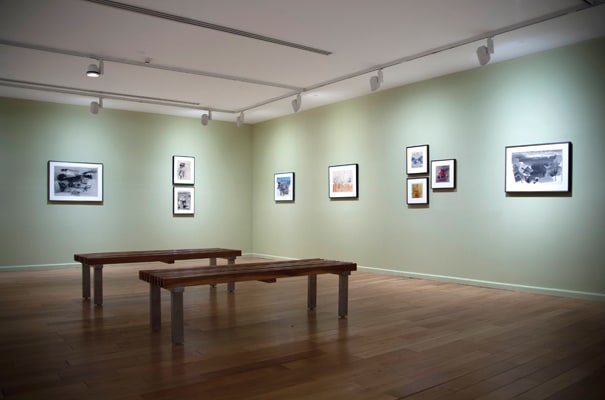
It is not often that museums furnish us with spaces for meditative contemplation—especially when they are located in bustling shopping malls. But nothing about this exhibition of Nasreen Mohamedi’s quiet artworks, at the Kiran Nadar Museum of Art (KNMA) in Delhi, fits into a typical mould. “Here is an artist that was able to achieve monumentality of experience through an 8-inch square of paper!" exclaims Deepak Talwar, whose gallery manages the estate of the late artist. A View to Infinity, curated by Roobina Karode, director and chief curator of the KNMA, is a chance to draw our own conclusions. And if size doesn’t matter, scale plays its part.
The solo was the brainchild of museum adviser Zara Porter-Hill. “It was based around the KNMA acquiring a large collection of Nasreen," she says. Billed as the KNMA’s first solo show as well as Mohamedi’s second retrospective in India since she died in 1990, A View to Infinity offers the largest accumulation of Mohamedis ever seen in one place. Kiran Nadar’s personal collection has more than 35 of Mohamedi’s works—encompassing line drawings, delicate paintings and black and white photographs (Mohamedi never exhibited the last in her lifetime). For this aesthetic extravaganza of 120 images, the KNMA’s compilation has been further supplemented with loans from choice Euro-American institutions (the list reads like a who’s who of the museum world).
It is ironic that this blockbuster-ish splash should be made for the least flashy of women. Mohamedi's untitled, undated, understated works speak volumes. If very early figurative paperworks sport touches of colour - like a green splodge next to the elbow of a woman drawing (a self portrait?) - in Mohamedi's last "line drawings", pale and grey pencil markings seem to barely skim the page. On a cream-coloured piece of paper, two faint ovals levitate over thinly ruled straight lines. They glide in and out of view.
"There were times when Mohamedi appeared to space out because she was locked into her own thoughts. Even this was about distilling the reality of the world," says Karode, who knew the artist well in the years before her death from Parkinson's disease in 1990. "She was my neighbor in Baroda (now Vadodara), I came to Delhi the year she died," she says.
Karode maintains that as Mohamedi found it harder to control her bodily movements, her art became increasingly pristine. In a late drawing, thin black triangle slices across a blank page - seeming to twist and turn rhythmically.
The show will track the phases of Mohamedi's career from the 1950s to the 1980s. "You'll be seeing her first early sketches, 1960s collages, then how she transited from more recognizable imagery to non-representational forms," Talwar says. "Finally, she arrived at a mature style of working in pen and ink that was so precise, so complex," he adds.
Karode herself delightedly whispers a little secret: She has reconstructed the artist's studio for us, complete with the drafting table Mohamedi designed, a little stool, geometry set, a low hanging light - and an unfinished drawing. "I've recreated her studio because I felt that was a way of recreating her. She always worked sitting on the floor, using the same tools that architects use. Entering her studio was like entering a state of mind. It was like a Sufi's den." Karode's resurrection of Mohamedi's studio breathes life into the past, introducing a mystical dimension to the way visitors experience Mohamedi's spiritually inflected art. "The studio will initiate viewers into her journey," says Karode.
Unlike most retrospectives, this one isn't ordered chronologically. "For her, time was a continuum, she was not interested in dates, but went back and forth. It was her road to infinity," Karode says. Because of the number of paper works and monochrome photographs the KNMA has amassed, Karode is able to make visual connections between periods. In a close-up photograph of a loom (from 1972), we see a fuzzy assemblage of thread standing out in all their frailty. Karode has "juxtaposed" the image next to grid drawings on khaki-hued paper, where grey lines intersect, recalling the smudgy patterns of handwoven cloth. Elsewhere, there is an early drawing of a lady with her back to us. The folds of her red-edged sari underscore Mohamedi's affection for textiles. "This was the thread of how she looked at the world: whether she was written, drawing or living, it was all the same - they were extensions of each other," muses Karode.
These days everyone in the art world has a stake in defining Mohamedi's practice. Mohamedi has been feted in the international press (frieze magazine, the New York times, Afterall journal... to touch the tip of the iceberg) as India's greatest "abstract" artist. In 2007, dOCUMENTA (12) in Kassel, Germany, famously placed her work next to that of American Minimalist Agnes Martin. "The change in Nasreen's status did not start after the dOCUMENTA (12) inclusion, which some may lead you to believe. Until we started representing Nasreen in 2002, there had not been a single solo show of her work outside India and the last one in India was 1991," Talwar says.
Whoever deserves credit for Mohamedi's posthumous triumph, it is best to read between her lines. Like her discreet black and white art, Mohamedi lived in the shadows. Karode was her student at the Maharaja Sayajirao University of Baroda in the 1980s. She remembers: "We were also so drawn to the narrative figurative tradition. But in Nasreen's work there was no obvious content, her imagery was extremely economical. She had no one supporting her then."
Karode's show attempts to redraw Indian art history. "Currently large and shiny works seem to awe people, this exhibition will realign the energy of the Indian art world," says Talwar. Karode agrees: "I think Nasreen was the first artist in India to really explore space - it is not just what you see, but about looking inward."
This is our opportunity to gaze again.
-Zehra Jumabhoy